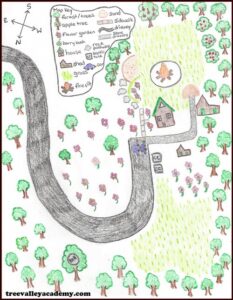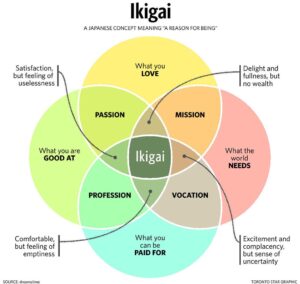Lee-Anne Ragan recently facilitated a Solution Session at OpEx365, Humentum’s annual conference re-imagined. Her creative and engaging session focused on virtual teambuilding. Through Lee-Anne’s session, attendees learned how to ensure their staff remain as connected as ever. Today she dives into Daniel Pink’s M.A.P. process of team building!
As a kid, I used to adore making map legends. The ones where you’d illustrate what colours and symbols meant, like on this kid’s map example below. It somehow made me feel creative and organized, and in control of my world.

Image credit: Tree Valley Academy
There are all sorts of creative maps these days.
- A body heat map that illustrates which rooms in a house are most and least used
- Historical maps of our streets – did you know you can literally scroll through time with Google maps?
- Migration mapping over 2000 years
- You can even map 25 years of marriage. I recently celebrated the same with my hubs, and based on the amazing data mapping book “Dear Data,” I made him 25 maps and gave one to him for each of the 25 days leading up to our anniversary. I mapped where we spent Christmas for the past 25 years, the vehicles we’ve owned over the years, the sizes of our homes, countries visited…you name it, I mapped it. My guy LOVES Starbucks mugs and collects them from all over the world, so I even mapped that (see the map above).
You probably have a few maps of your own on your computer desktop and likely even a few more around your home – be they crumpled, bunched up in your junk drawer, or at the ready for adventures in your glove compartment.
I can almost guarantee you that you don’t have a map for learning, and/or a M.A.P. for your well-being.
M.A.P. is an acronym based on Daniel Pink’s work. It looks at our three key psychological needs. Here are the signposts to follow on your and/or your team’s M.A.P. Hit these, and your team will hit it out of the park.
M STANDS FOR MASTERY
We all need a sense of mastery, of competence. Ask yourself what you can do to give your team members a sense of mastery.
Example: Years ago, I flew to NYC to attend a conference. In the pre-conference materials were instructions on how to learn a ‘simple’ dance. A link was given to a video, which we were to use to learn said dance. Enter headaches, strife, and toil. The video was super hard to follow. And even though I absolutely adore dancing, I was put off. My motivation tanked, and I was frustrated. I now use that experience when I’m doing training workshops to show how learning can lead to mastery or can actually confound it.
I demonstrate how we can hamper or amp up mastery using a rhythmic cup game. I play three different videos. Each one of them leads to or throws a wrench into mastering the game. Here’s one of the examples – note it’s the hardest to follow!
How can you and your team take a deep dive into mastery?
Spend some time reflecting on:
- What do you and your team love to do?
- What do you and your team need to work on?
- What can generate income?
- And finally, what are you and your team good at?
Put together these are known as Ikigai – a powerful combination of passion, mission, vision, and vocation. They’re also a wonderful pointer towards what you may want to prioritize spending time on to master.

A STANDS FOR AUTONOMY
Especially when ambiguity is rampant (when will we ever get out of our Covid PJs?!), the need for autonomy is high. We all need a sense of control or agency. Ask yourself what you can do to give you and your team members a sense of autonomy.
One way to underscore this and lead with a sense of autonomy, is to set some goals once you’ve reflected on your Ikigai. Caveat: I know some people have knee-jerk reactions to the word goal. If ‘goals’ doesn’t resonate with you, substitute “stuff I/we want to do.”
Be sure to include some stretch goals, or some BHAGS (big, hairy, audacious goals, a term coined by Jim Collins and Jerry Porras). And also include some wee, tiny goals. Check out this post for a worksheet if you want a template on setting your own, what I call Mountain, Medium, and Molehill goals.
Then comes the fun part. Put on some relaxing music and imagine…
- Imagine yourself reaching your BHAG, Mountain, Stretch goal.
- Like you’ve done it! You’ve achieved your goal. It’s in the bag.
- Then pay attention to how you’re feeling, what you’re thinking, if there are any blocks, who might be around you, what you’ve done etc.
- You may even want to look at what you’re wearing, where you are, ‘when’ are you (how far in the future), etc.
This simple exercise does three things:
- It helps you focus on important goals / ‘stuff you want to do’.
- It illuminates what it would feel like to achieve them.
- And by doing all that, it gives you and your team more autonomy.
By the way, the more challenging being in ambiguous situations is for you and your team, the more you’ll be inclined to reach for autonomy. Check out What’s your tolerance for ambiguity? (And why it’s key to know) which includes an ambiguity quiz to measure your tolerance for said ambiguity.
P STANDS FOR PURPOSE
We are our best selves when we’re pulling together, working towards a shared goal, a common vision. Ask yourself what you can do to give you and your team members a sense of purpose.
Simon Sinek’s work on finding your why is an excellent place to start. He lays out a process for how to find your why, vision, purpose that can’t be n.
Don’t have enough time for a full-blown process? Try something simple such as having your team create an online board that maps their thoughts around their purpose. Padlet is a great tool to use because it’s super easy. Here’s an example based on wellness. Notice how you can easily add text, images, and even GIFs.
After you’ve spent time on Master, Autonomy, and Purpose, there’s one more key thing to do. One last tip for your M.A.P. is to make sure, make sure, make sure that you record your work. And make time to review. Like seriously, put the review date in a reminder right now.
The research is really clear on this point – when you have a record of your and your team’s learnings, insights, goals, etc. you are much more likely to succeed at them. It doesn’t matter how they’re recorded – pick a way that works for you and your team, for example:
- Make an audio recording
- Rely on good old pen and paper
- Make a padlet (see above for an example)
- Create a video
- Create a shared Google Doc and collaborate
While some people thrive working virtually, it’s a descent into a long dark tunnel for others. And regardless of who is (or isn’t) at home with you, whether you have too much company (hello kid-is-interupptis) or too little, working in a global pandemic is no joke for individuals and for teams.
So please, for all our sakes, pay attention to your and your team’s M.A.P. By zeroing in on how you can leverage mastery, autonomy, and purpose, you’ll all be better off, which means we all win because then you can focus on the kinds of social change work that you and your team do so well. And we all need that.
Now go on and learn, laugh and lead
Learn
For Mastery, spend some time reflecting on:
- What do you and your team love to do?
- What do you and your team need to work on?
- What can generate income?
- And finally, what are you and your team good at?
For Autonomy, do the guided visualization above and discover your tolerance for ambiguity
For Purpose, check out Simon Sinek’s work and/or make a padlet with ideas pointing to your purpose
Laugh
- You can even ‘map’ your friends, like this funny little fellow does with delightful insight.
Lead
- Share your M.A.P. with your team and invite them to do the same.
P.S. Want to receive invitations to Lee-Anne’s monthly Learning and Development Roundtable? Easy peasy. Sign up here.

